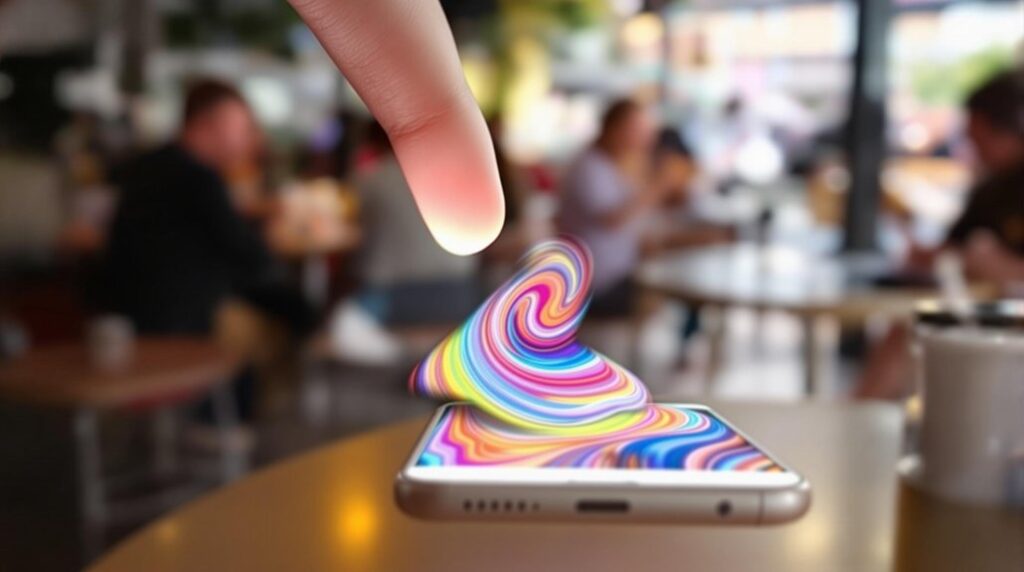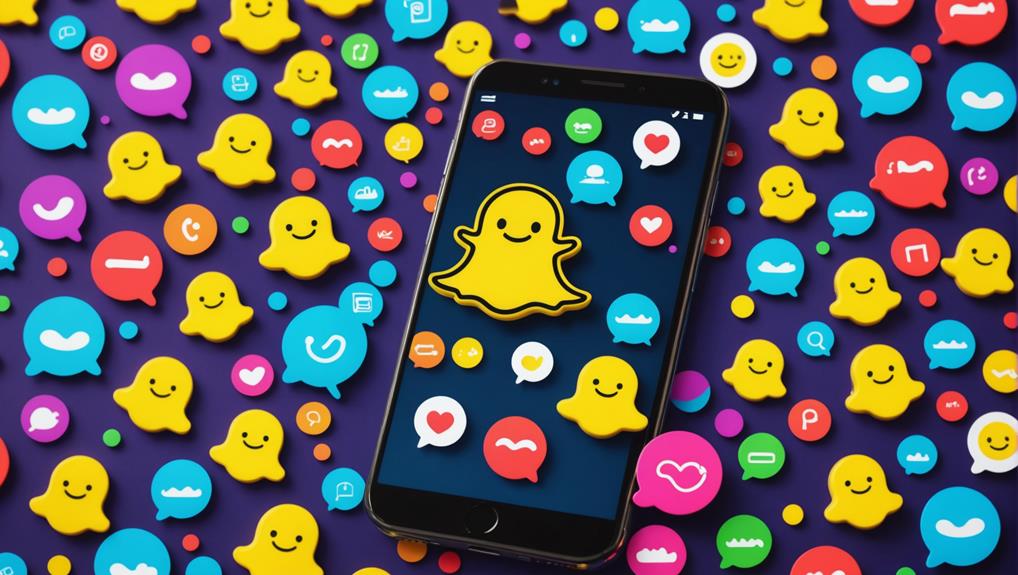"Wgat" typically appears in Snapchat texting either as a typo for "what" or an acronym for "Who Gives A Toss." As an expression, it encapsulates indifference or dismissive humor, resonating with the platform's youthful and casual communication style. Emerging from the UK in the early 2000s, "WGAT" illustrates the linguistic shift towards efficiency and informality driven by digital interactions. Its usage, whether as a genuine expression or an accidental typo, underscores the adaptable nature of language in technologically constrained environments. Understanding its varied interpretations can enrich one's grasp of evolving digital slang nuances.
Key Takeaways
- "Wgat" is often a typographical error for "WGAT," meaning "Who Gives A Toss," conveying indifference humorously.
- WGAT originates from UK texting culture, emphasizing speed and conciseness in communication.
- It's popular among youth for expressing disinterest in a casual, playful manner on Snapchat.
- Understanding WGAT enhances conversational dynamics and minimizes miscommunication in digital exchanges.
- WGAT reflects the trend of informal, efficient language evolution in online communication.
Understanding WGAT on Snapchat
How does the abbreviation WGAT encapsulate the evolving nature of communication on Snapchat? WGAT, standing for "Who Gives A Toss," represents a shift towards succinct and informal digital interactions. Its usage on Snapchat reflects a broader trend among social media users, particularly youth, who prefer casual and direct expressions to steer social dynamics.
The implications of WGAT extend beyond mere brevity; it signifies a cultural adaptation to digital communication that prioritizes efficiency and humor over formality. This abbreviation allows users to convey indifference in a playful manner, mitigating potential offense in conversations that might otherwise become tedious or disengaging.
The variations of WGAT usage on Snapchat highlight its versatility in digital discourse. Whether employed as a standalone comment or integrated into longer messages, WGAT serves as a linguistic tool that enhances conversational fluidity. Its popularity underscores a preference for communication that is both lighthearted and effective, aligning with Snapchat's ephemeral nature.
Origin of the Term WGAT
The term WGAT, an abbreviation for "Who Gives A Toss," originated in the United Kingdom, reflecting a broader linguistic trend emerging in the early 2000s. This period marked the rise of texting culture, where brevity became essential in digital communication. WGAT illustrates the cultural significance of language evolution, as it encapsulates the shift towards more informal and efficient modes of expression. Its emergence aligns with the growing popularity of mobile texting, where speed and conciseness are prioritized.
As digital platforms like Snapchat gained traction, WGAT became a staple among youth, who embraced its casual tone. This development underscores the dynamic nature of language, particularly in digital spaces, where new terms are rapidly adopted and disseminated. The phrase's polite alternative to cruder expressions of indifference further highlights its adaptability, making it suitable for diverse social contexts.
The global spread of WGAT underscores the influence of British English on internet slang, demonstrating how regional expressions can achieve international reach.
WGAT and Its Meanings
In digital communication, particularly on platforms like Snapchat, WGAT serves primarily as an abbreviation for "Who Gives A Toss," reflecting a linguistic adaptation that resonates with a younger audience. This British slang expression conveys indifference or a lack of concern, aligning with the casual and often abrupt nature of modern digital interactions.
However, WGAT interpretations extend beyond this primary meaning, as its usage reflects the dynamic and evolving language landscape of online communication.
Here are some key insights into WGAT variations:
- Primary Meaning: WGAT stands for "Who Gives A Toss," a phrase that has become popular among youth on social media.
- Typographical Error: Often, WGAT is mistakenly used as a typo for "what," leading to humorous exchanges that highlight the significance of context in digital conversations.
- Cultural Influence: The term's rise in the early 2000s coincides with the burgeoning texting culture, driven by the need for concise communication due to character limits.
- Contextual Understanding: Grasping WGAT interpretations is essential for maneuvering the complexities of modern digital language and ensuring effective communication across diverse platforms.
WGAT in Casual Texting
Snapchat's dynamic landscape fosters the emergence of abbreviations like WGAT, a term reflecting the platform's casual communication ethos. WGAT, standing for "Who Gives A Toss," encapsulates a casual dismissal attitude prevalent in today's texting culture, particularly among younger demographics.
With its roots in British slang, WGAT serves as a linguistic tool for succinctly expressing indifference or apathy towards a subject. This mirrors the broader trend in digital communication, where brevity is valued, and character limitations have historically driven the creation of such abbreviations.
The appeal of WGAT in casual texting lies in its ability to convey a message quickly, often adding a humorous or lighthearted tone to conversations. Its continued relevance underscores a significant aspect of texting culture: the need for efficient communication methods that resonate with the demographic's desire for quick, yet expressive interactions.
However, the use of WGAT requires contextual sensitivity. While it effectively dismisses mundane topics, its employment in more sensitive discussions may inadvertently result in perceived rudeness or insensitivity. This highlights the balancing act of maintaining casual communication without undermining the nuances of the conversation's emotional undertones.
How WGAT Is Used
WGAT, an abbreviation for "Who Gives A Toss," is frequently employed on Snapchat to convey casual indifference, reflecting broader digital communication trends among younger users.
Its usage aligns with the informal and playful nature of social media interactions, where expressing apathy towards trivial matters can redirect conversations towards more engaging topics.
Analysis of social media behavior suggests that while WGAT can enhance conversational dynamics in casual contexts, its application should be mindful of the potential for misinterpretation in more serious exchanges.
Expressing Casual Indifference
Demonstrating a trend toward succinct communication, the use of "WGAT" on Snapchat underscores a prevalent inclination among users, particularly the younger demographic, to express casual indifference with efficiency. This acronym, standing for "Who Gives A Toss," functions as a casual response, allowing individuals to offer a playful dismissal of topics deemed unimportant or mundane.
This methodology aligns with the broader trend of informal communication styles on social media, wherein brevity and levity are valued. The strategic use of WGAT enables users to redirect conversations from trivial gossip or uninteresting details to subjects that spark more engagement.
In analyzing the dynamics of WGAT usage, several trends emerge:
- Casual Responses: WGAT provides a mechanism for concise reactions, minimizing the need for lengthy explanations.
- Playful Dismissal: It conveys disregard without appearing harsh, preserving a friendly tone.
- Demographic Appeal: Its popularity among younger users highlights a shift towards informal digital vernacular.
- Efficient Communication: WGAT epitomizes the preference for succinctness in conveying disinterest or apathy.
Thus, WGAT's role in digital dialogue exemplifies how modern communicators leverage brevity to articulate indifference while maintaining conversational harmony.
Common Social Media Use
In the domain of digital communication, the utilization of acronyms like "WGAT" on social media platforms, particularly Snapchat, serves as a fascinating case study in modern interaction dynamics. This acronym, standing for "Who Gives A Toss," encapsulates a social media trend where users navigate casual conversations with a blend of brevity and indifference.
Its frequent use among younger demographics highlights a shift towards informal communication styles that prioritize efficiency over formality. The strategic deployment of WGAT allows Snapchat users to dismiss trivial matters or redirect discussions without overtly offending their conversational counterparts.
This reflects an emerging trend where humor and lightheartedness are leveraged to maintain a dynamic and engaging social environment. By incorporating WGAT into their digital vernacular, users can swiftly pivot conversations towards more stimulating topics, thereby enhancing the overall social interaction experience.
However, the adoption of such terms requires a careful balance; while WGAT can infuse humor into exchanges, it necessitates a discerning application to avoid potential misunderstandings in more serious or sensitive discussions.
This underscores a critical aspect of social media trends: the necessity for contextual awareness in digital communication.
Digital Communication Trends
Examining the landscape of digital communication trends reveals how acronyms like "WGAT" play a significant role in shaping modern interaction paradigms on platforms such as Snapchat. As digital communication evolves, youth slang like WGAT reflects a nuanced understanding of social interactions, especially among younger demographics. This phenomenon underscores the importance of brevity and the preference for casual, efficient exchanges.
- Cultural Origins: WGAT, which stands for "Who Gives A Toss," originated in the UK and has transcended borders, highlighting the global spread and influence of youth slang.
- Communication Style: It typifies a casual communication style, allowing users to express disinterest without resorting to rudeness, thereby maintaining a lighthearted atmosphere in conversations.
- Practical Usage: Snapchatters use WGAT to shift focus from trivial topics, demonstrating a strategic use of language to manage dialogue dynamics.
- Historical Context: The abbreviation traces back to early text messaging, where character limits necessitated concise exchanges, a practice now embedded in digital communication norms.
Understanding such slang is essential for maneuvering social media effectively, ensuring communication remains clear and socially adept. This reflects a broader trend where language continuously adapts to technological constraints and cultural shifts.
WGAT vs. Other Slang
Understanding the nuances between WGAT and other slang terms in Snapchat texting is essential for grasping the subtleties of digital communication. WGAT, standing for "who gives a toss," carries specific implications reflecting a laid-back attitude, often used to humorously dismiss topics. This term, prevalent among younger demographics, highlights variations in how indifference is expressed.
In comparison, IDC ("I don't care") and IDGAF ("I don't give a f***") also convey indifference but differ in emotional intensity. IDC suggests a general lack of concern, while IDGAF indicates a more emphatic disregard.
Analyzing the usage of WGAT alongside other slang terms reveals distinct communication strategies in digital interactions. For instance, DKDC ("don't know, don't care") combines ignorance with apathy, showcasing a different nuance from WGAT's casual dismissal.
These subtle differences illustrate the complexity of evolving language trends among digital natives. WGAT's implications go beyond mere indifference; its usage reflects a cultural shift towards a more relaxed and humorous communication style on platforms like Snapchat.
Typo or Intentional Use?
The occurrence of "wgat" in Snapchat texting often stems from typing errors due to the proximity of the "G" and "H" keys, which can result in humorous exchanges when clarified.
However, its intentional use as a slang expression can add a layer of playful or sarcastic nuance to conversations, reflecting the dynamic adaptability of digital communication.
Understanding whether "wgat" is a typo or a deliberate choice is essential for interpreting tone and context accurately, thereby minimizing potential miscommunication.
Typing Mistakes and Humor
In the domain of digital communication, the term "WGAT" exemplifies a fascinating intersection of typographical error and intentional humor.
Within texting culture, this common misspelling of "what" often arises due to the proximity of the letters "H" and "G" on the keyboard. This minor error can lead to humorous exchanges, as participants in a conversation may find themselves playfully clarifying the intended word. Such interactions highlight the light-hearted nature of communication on platforms like Snapchat.
The ambiguity surrounding "WGAT" contributes to its versatility and appeal. As a typo, it can evoke laughter and create a shared moment of understanding between users. Additionally, the potential for deliberate use adds an extra layer of humor and sarcasm, reflecting the informal and relaxed tone that characterizes much of social media interaction.
The following points illustrate the dynamics of "WGAT" in digital communication:
- Accidental Humor: Typographical errors often lead to spontaneous amusement.
- Playful Clarification: Users may engage in light-hearted exchanges to resolve misunderstandings.
- Intentional Use: "WGAT" can be adopted for comedic effect, enhancing conversational engagement.
- Ambiguity as a Tool: The dual nature of "WGAT" enriches communication, allowing for varied interpretations.
Intentional Slang Expression
Maneuvering the domain of digital slang, "wgat" serves as a prime example of how typographical mistakes can evolve into intentional expressions within online communication. This term, often originating as a typo due to the closeness of the "G" and "H" keys, morphs into a tool for playful confusion. Users intentionally employ "wgat" to mimic the sound of "what," introducing a layer of digital creativity into their interactions.
This usage exemplifies the adaptability of language in digital spaces where efficiency and humor are paramount. In Snapchat and other texting contexts, particularly among younger demographics, "wgat" adds a lighthearted or sarcastic tone to conversations. Its interpretation hinges on contextual cues, varying between indifference and genuine confusion.
Consequently, "wgat" embodies the flexible nature of digital communication, where users continuously adapt linguistic norms to suit evolving conversational styles. This adaptability underscores the creativity inherent in digital exchanges, where language is not static but rather a dynamic tool for expression.
The evolution of "wgat" from accidental keystroke to intentional slang underscores a broader trend in how digital communication fosters linguistic innovation, emphasizing the intersection of technology, creativity, and social interaction.
Cultural Impact of WGAT
Emerging from the digital lexicon, the term WGAT, an abbreviation for "who gives a toss," encapsulates a significant cultural shift towards more casual and informal communication styles on platforms like Snapchat.
The cultural significance of WGAT highlights generational differences in communication preferences, with younger demographics favoring brevity and informality. This trend underscores a broader movement in digital communication, where:
- Regional Influence: WGAT, a British expression, transcends geographic boundaries, illustrating how regional slang permeates global digital interactions.
- Language Evolution: The rise of such slang terms reflects the rapid evolution of language, adapting to the unique context of social media.
- Social Dynamics: Understanding WGAT enhances social dynamics, fostering peer group belonging and shared understanding among Snapchat users.
- Indifference and Dismissal: The term serves to convey casual indifference, aligning with the relaxed and spontaneous nature of Snapchat conversations.
The global traction of WGAT demonstrates how digital platforms act as catalysts for linguistic exchange, bridging cultural gaps and redefining communication norms.
As social media continues to shape language, the impact of terms like WGAT on interpersonal dynamics and cultural discourse becomes increasingly evident, offering insights into the ongoing evolution of human interaction.
Popular Snapchat Slang
How does the rapidly evolving lexicon of digital platforms like Snapchat reflect broader societal changes? The dynamic nature of Snapchat Trends and Youth Communication highlights the growing inclination towards brevity and immediacy in interactions. As youth culture drives the innovation of language, abbreviations like WGAT demonstrate how linguistic efficiency meets the demand for rapid messaging. This trend underscores a shift towards simplified communication without sacrificing nuance or expression.
| Term | Meaning | Usage Context |
|---|---|---|
| WGAT | Who Gives A Toss | Expressing indifference |
| SMH | Shaking My Head | Disapproval or disbelief |
| BAE | Before Anyone Else | Referring to a close person |
| FOMO | Fear Of Missing Out | Anxiety over exclusions |
This table illustrates the diversity and functionality of Snapchat slang, showcasing how these abbreviations are embedded into Youth Communication to convey complex emotions succinctly. By adopting such terms, users not only streamline their interactions but also foster a sense of belonging within the digital community. Additionally, as these slang terms permeate global youth cultures, they reflect a broader societal trend towards connectivity and understanding. Hence, understanding and utilizing Snapchat slang becomes essential for effective participation in modern digital dialogues.
Frequently Asked Questions
What Does WGAT Mean in Texting Funny?
Examining the wgat meaning and usage in texting reveals its humorous nature as an acronym for "Who Gives A Toss." This expression facilitates lighthearted communication, often employed to dismiss trivial discussions, reflecting evolving digital communication trends.
What Does WGAT Mean in Tiktok?
On TikTok, "WGAT" is mainly interpreted as a humorous misspelling of "what," reflecting the platform's informal communication style. Additionally, its usage can denote surprise or indifference, showcasing the adaptive nature of language in digital environments.
What Does IG Mean in Snapchat?
In Snapchat slang, "IG" stands for "I guess" or "Instagram," depending on context. This highlights the platform's reliance on texting abbreviations, facilitating rapid communication. Understanding context is essential to accurately interpret these expressions' intended meanings.
Conclusion
The term "WGAT" in Snapchat texting is mainly a typographical error for "WHAT," although its repeated occurrence in digital communication suggests a broader acceptance in informal contexts. Analysis of its usage highlights the fluidity and adaptability of language within digital platforms, where speed often supersedes accuracy. This phenomenon underscores the dynamic evolution of slang, as typographical errors become integrated into everyday vernacular. Comparisons with other slang terms reveal a trend where digital communication increasingly influences linguistic conventions.




